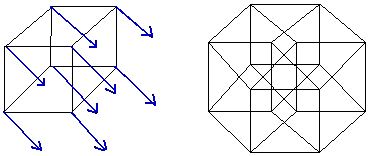New Linux users are often repelled from the operating system, by some things that are not directly noticeable, yet they cause a weird feeling that something is wrong. Here are some of such things I've discovered after using Linux (Kubuntu and Ubuntu) for a year:
1. Fitt's Law ViolationsFitt's Law is one of the things that Windows is very good at. It's an ergonomics law that requires the system to allow its users rapid movements - particularly the cursor movement. For example, when you want to close a full-screen window, and you shoot your mouse cursor into the upper-right corner of the screen, you would expect that it would now be located on the window-closing X button. This is not the case in many KDE window decoration themes. Instead, you have to move the mouse slightly to the lower-left and aim for the X. What happens in some cases is the cursor actually misses the X button and you lose window focus. But more often you hit the window border, and the cursor changes into a resizing cursor. A nice example for this is CompizFusion/Beryl. In KDE you can use the
Crystal window decorator theme (with Vista-style buttons), but for Emerald (Compiz's default window decorator), I think there's just no solution. This is causing a great annoyance, but it not really noticeable at first.
On some Gnome-based systems like Ubuntu Linux (without Compiz) it's even worse: You always have to aim carefully when closing windows, otherwise you can hit the system shutdown button, that is just a few pixels above. I always remove that button. It's still a Fitt's Law violation, but at least you don't power off your computer instead of just closing a window. Here's a screenshot of the upper-right corner of the screen to show what I am talking about:

Another Fitt's Law violation is the way full-screen window scrollbars behave like, though in this case it's more of a KDE-specific problem. Again, by thrusting your mouse to the very edge of the right border, you often cannot grab the scrollbar. You have to move your mouse a bit to the left, or you will just hit a blank, unused edge that is one or more pixels wide. I have found that some Window Styles (in a combination with a proper Window Decorator Theme) do not have this problem, but sadly, most do:

(notice the pointless border on the utmost right side)
People say Linux is fast, Faster than Windows in fact. They are somehow correct, BUT, Windows is MUCH faster when it comes to loading applications. Why does it take Linux to fully run Firefox (not counting loading the webpage) about 3 seconds, while in Windows, the same thing happens in
less than half a second?!
Some people have suggested a method called
prebinding (similar terms: preloading , prelinking, prefetching). I myself have tried a program called
preload (*ubuntu users can install it by running:
sudo apt-get install preload
in the terminal). I noticed a slight performance increase (Firefox loads in about 2.5 seconds), but it is FAR from the speed I get in Windows. I really hope this issue gets addressed more seriously soon, because it is causing a feeling of irresponsiveness and slowness. This again, is repelling new users from accepting Linux as a primary operating system.
3. Inaccurate Mouse MovementI have a MX1000 Laser mouse. A _
laser_ mouse. That means it should be VERY accurate, right? Well that was not the case. When I tried moving it only a few pixels it seemed to be a bit jumpy. It drove me mad when I tried to play Minesweeper. Once again, this is not something everybody will even notice, but it will annoy them subconsciously.
Luckily there is a solution. Change the rate at which Linux polls your mouse. Here are the instructions for *ubuntu users:
http://ubuntuforums.org/showthread.php?t=392494For those who want to know more about mouse-polling I suggest you read the
Gentoo-Wiki.
That's it for now. I plan to add more, because we need a good list of these things.
 However, there is a way to make Metacity blurry like the rest of the window.
However, there is a way to make Metacity blurry like the rest of the window.



